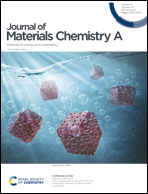Direct observation of the in-plane crack formation of O3-Na0.8Mg0.2Fe0.4Mn0.4O2 due to oxygen gas evolution for Na-ion batteries†
Abstract
Crack formation is considered one of the significant failure modes of layered oxide cathode materials for Na-ion batteries because particle cracks accelerate electrolyte decomposition, transition metal dissolution, and electrical contact loss. However, the crack formation mechanism of layered sodium transition metal oxides has not been fully understood yet. Herein, the in-plane crack formation mechanism of O3-type Na0.8Mg0.2Fe0.4Mn0.4O2 is demonstrated in terms of oxygen gas evolution due to air-exposure using in situ mass spectrometry and various atomic-scale analyses. When Na0.8Mg0.2Fe0.4Mn0.4O2 is exposed to air, Na+ ions are unevenly deintercalated in a form of stripe pattern along the in-plane direction. The deintercalation of Na+ ions gives rise to phase transition from the layered structure to the disordered structure, including spinel-like and rock salt-like structures, resulting in forming the nanoscale vertical heterostructure of alternating layered and disordered phases along the out-of-plane direction. The formation of the disordered structure is accompanied by oxygen gas evolution. As a result, cracks occur along the in-plane direction of Na0.8Mg0.2Fe0.4Mn0.4O2 because of the internal gas pressure due to oxygen gas evolution. Moreover, air-stable surface-modified Na0.8Mg0.2Fe0.4Mn0.4O2 is introduced to suppress crack formation, leading to excellent electrochemical performance, such as stable capacity retention over 200 cycles.



 Please wait while we load your content...
Please wait while we load your content...